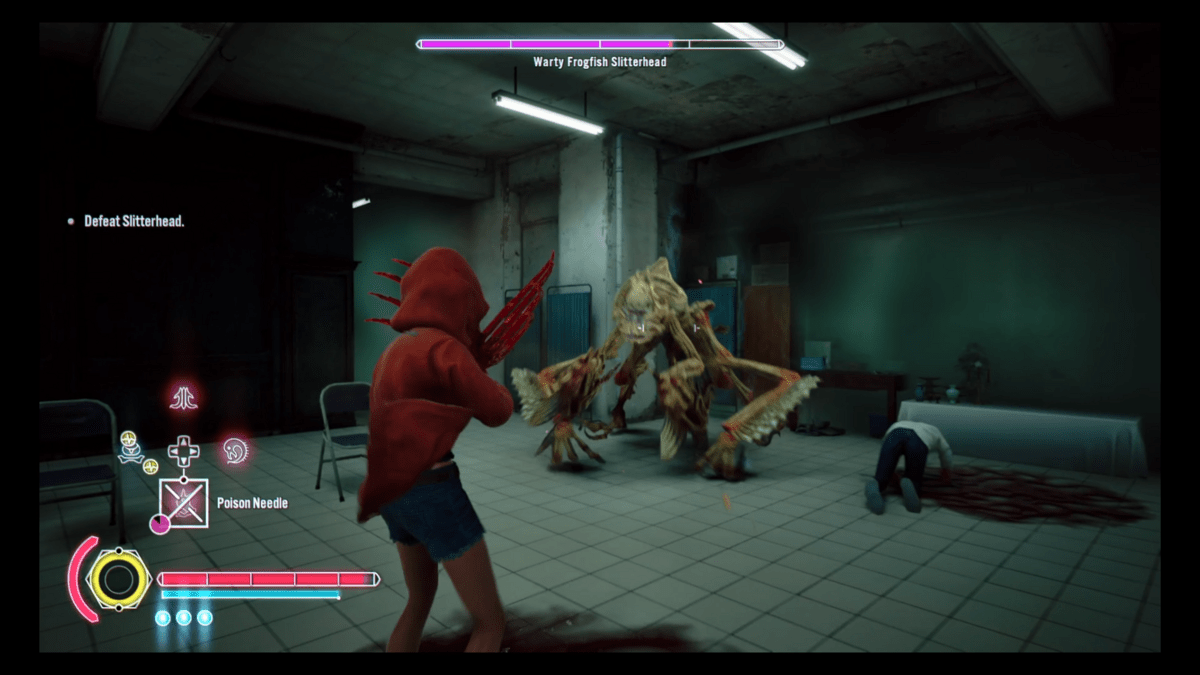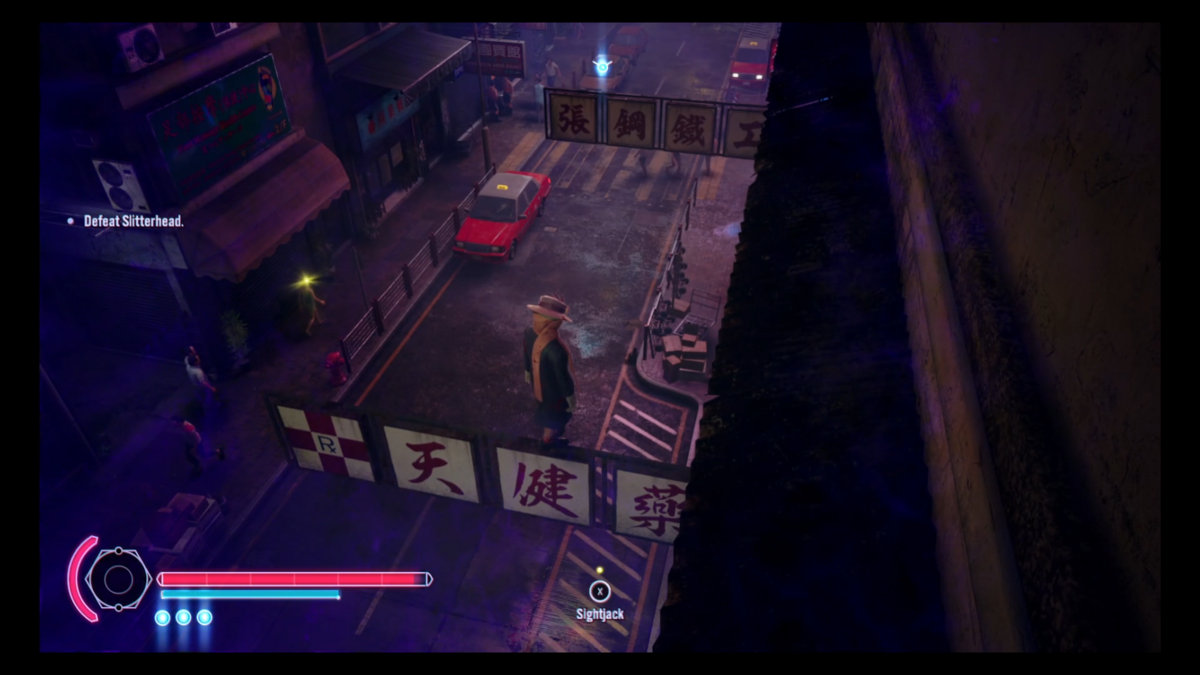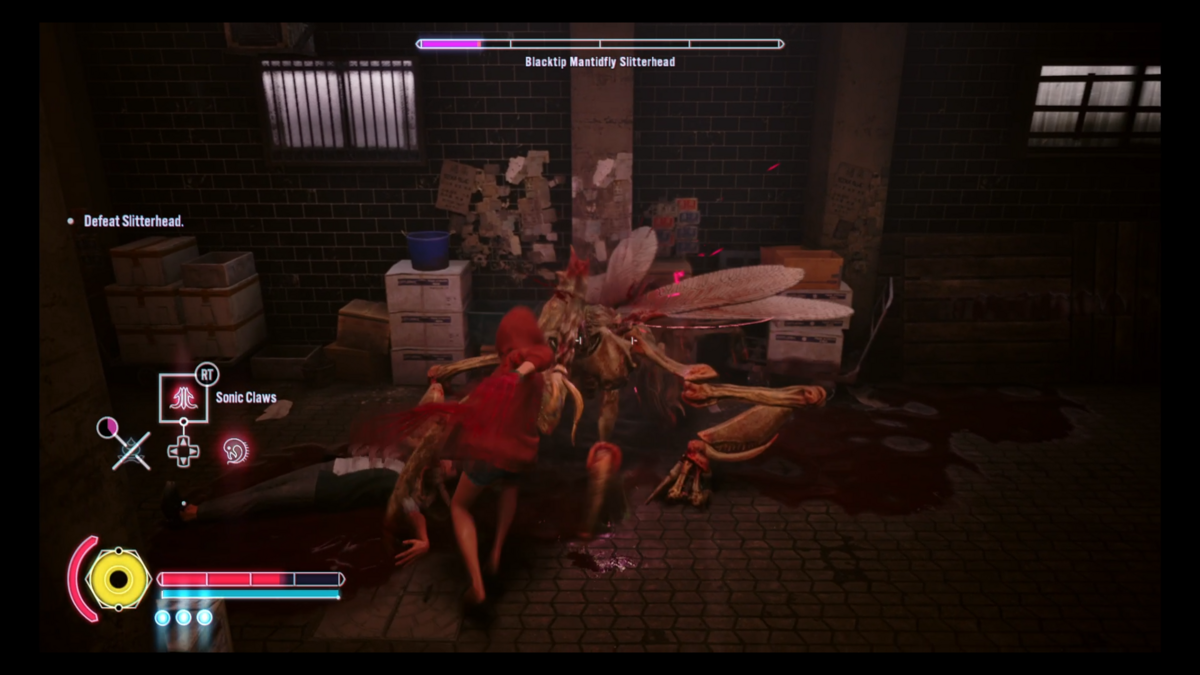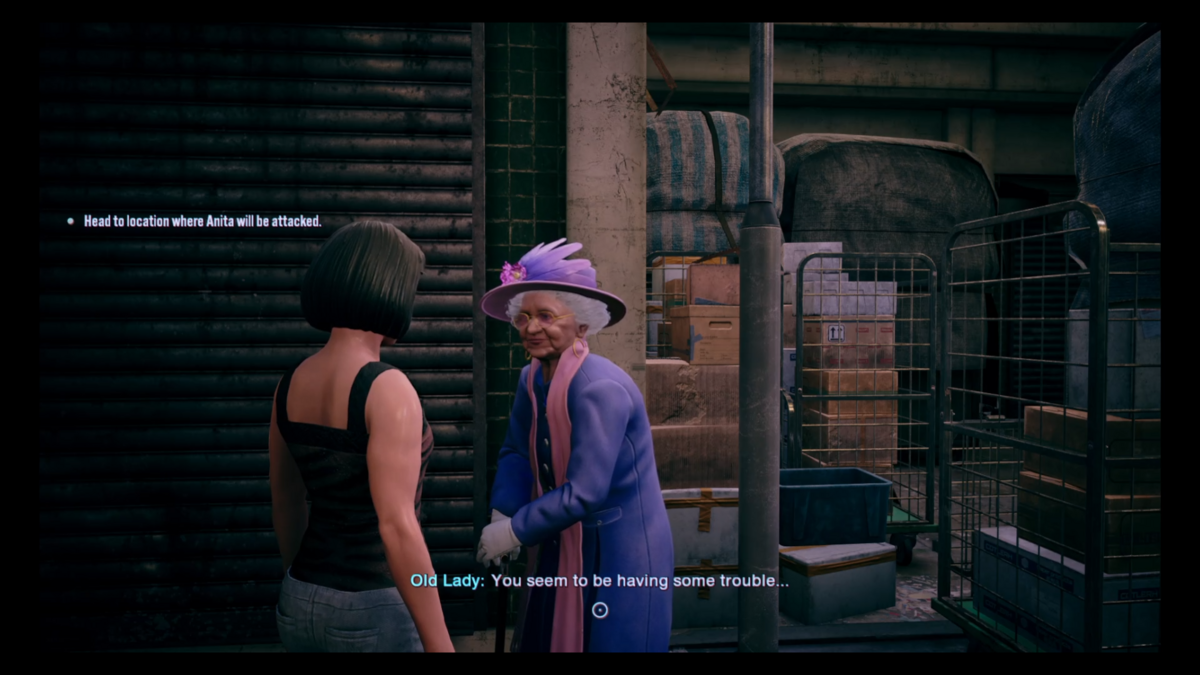In the seedy underbelly of Kowloon, a spirit stirs to consciousness before it jumps into and possess the body of a stray dog. It travels through the narrow backstreets, eventually upgrading to a human body, yet still lost on its name and purpose. A woman calls out to him, but in a gruesome display, her head splits open to reveal the monstrous, parasitic creature that had devoured the brains of its original host. This time, it’s got its sight set on you. Thus opens up Slitterhead, the debut title from Bokeh Game Studio, which had been founded by the creatives behind Siren, Silent Hill, and Gravity Rush.
Similar to Siren, the Slitterhead plot can be inscrutable at times. It follows Night Owl, a Hyoki that is an otherworldly spirit that can possess sentient beings. Though Night Owl doesn’t remember all the details about his past, he does know that he has to eliminate the Slitterheads wandering around Kowloon. Like Night Owl, Slitterheads can possess people and take over their bodies. However, their method of doing so is to literally consume their brains and essentially wear their bodies as a shell. In Night Owl’s pursuit of the Slitterheads, he encounters a dying girl named Julee. After possessing her, he not only restores her back to full health, but they’re incredibly in sync.
Julee is a Rarity, or a human who boasts high affinity with Hyoki. She’s not the only one. As Night Owl and Julee continue their mission to slaughter all of the Slitterheads within Kowloon, they encounter and save other individuals with the potential to host Night Owl. As they work together to rid Kowloon of the Slitterheads plaguing the streets and terrorizing the populace, Night Owl discovers the ability to turn back time and restructure the timeline. With this power, as well as the help of the Rarities, they fight to save Kowloon from its doomed future.

In terms of genre, Slitterhead wears a lot of hats. It’s predominantly an action-RPG, though it does feature stealth elements as well. You technically control Night Owl, the Hyoki that can teleport itself between bodies. So for stealth portions, you’re able to travel from body to body to avoid detection as you sneak around facilities. Because there are some limitations in how far the Hyoki can leave a body, as well as it needing open access to one, it’s not as easy as it sounds. These stealth missions were quite fun since they were a deviation from the norm, but there weren’t that many in the game. You can use Sightjack when it comes to hunting down a Slitterhead hiding in a crowd, but the Siren fangirl in me wished that Sightjack had a place in these stealth sequences as well.
This body-hopping mechanic can make battle very fun, which is great because that’s the majority of the game. You can switch bodies while your first one is in the middle of a combo to keep up the pressure or if you need to target another enemy. Barring fights where you want to stay in your Rarity or you don’t have any other random people milling about, you can also use this mechanic to get out from corners when enemies trap you there. The combat is fast-paced, but it remains challenging with the number of enemies the game can throw at you.
Chase sequences are the final type of gameplay in Slitterhead. Frankly, it didn’t take long for these to become tedious. While it’s fairly easy to catch up to the Slitterhead you’re pursuing using the body-hopping mechanic, they feel like they go on for a very long time. Usually, they’re scripted to end after the Slitterhead reaches a destination or you whittle down their HP enough. But it gets rather dull after the first time and unfortunately, the game throws these at you quite often. Aside from using the body-hopping mechanic to possess an NPC in the direction the Slitterhead is running towards so that you can cut them off and get in some hits, you can also use blood to parkour after it.

While the main meat of the game is the combat, it felt lacking in some ways. Everyone feels good to use, and it takes a bit of practice to rein yourself in when doing combos. It can be hard to block or dodge on the fly while you’re in the middle of an animation. All of the characters have their pros and cons. For example, Betty boasts amazing strength, but her inability to move unless you’re possessing her means she can’t help civilians if they’re dying. Meanwhile, Edo can revive civilians and he’s a powerhouse of a character, but he has a short reach and lacks ranged options. Choosing who you bring depends on personal preference until the latter stages, where you really want to have Julee with you.
But the main issue with the game is its repetitive nature. I already mentioned that the chase sequences are, but the combat can be, too. There aren’t a lot of variations in combos or enemy types. While there are different Slitterhead forms, the optimal strategy really stays the same, no matter who you’re using. Most of the game is parrying attacks and then getting your licks in. You may need to jump to a new body or stop and heal if you’re HP is low, and then you repeat the above procedure. That’s it. Even if you use long-ranged characters like Doni, you’ll have to do the usual parry-attack-dodge dance because of how quickly Slitterheads can close the distance and the long cooldown time of active skills.

Differences between Slitterheads are pretty minor. Mantis Slitterheads are faster and more difficult to parry, for example. Later bosses have moves you can’t parry and must dodge. They can down civilians too, so you might scramble a bit getting everyone up. But as a whole, what you have to do remains the same no matter who you’re facing. So it can start to get monotonous. Yes, the game does throw you new challenges like needing to keep a certain amount of people alive per stage, but it’s not hard to work around this limitation by either luring enemies away from the injured or with Julee. The game takes about twenty hours to complete if you take the time to look for collectibles or need to restart levels. So a little bit of variety to the enemies would’ve been nice.
Slitterhead was a bit of a mixed bag for me. After rewatching the gameplay trailer, I can say that what you see there is really accurate to what you’re doing in the game proper. I also understand that Bokeh Game Studio encountered problems during development thanks to the COVID-19 pandemic. When it came to this game in particular, I was more intrigued to see the story than the gameplay. After Silent Hill, Gravity Rush, and, yes, Siren, I had pretty high expectations for what kind of narrative Slitterhead would have. The story starts to become generic around the halfway point, and the ending felt like another fake-out. It almost feels incomplete, though I do admit that I’m still missing a few Hyoki Memories that might be key to fully comprehending it.
As someone who relies a lot of visuals to remember a story, I struggled at times to retain the finer details of Slitterhead. I understand the broad strokes of it and could give someone a synopsis of what it’s about. However, I definitely need to sit and either sift through my collectibles or hunt more down to fully grasp stuff about characters like Night Owl and Yin Yue. The amount of text-only conversations would be fine on their own, but Slitterhead’s time loop mechanic, as well as symbols to denote the alien language the Slitterheads and Night Owl use, became a little hard to follow. I do wonder if Bokeh Game Studio wanted a more visual archive like what was in Siren, but constraints during development prevented them from doing so.

If there’s one thing I love about Slitterhead with no ifs or buts, it’s Betty. Oh my goodness, do I love her. There’s something about this put-together British lady who looks like Queen Elizabeth II, except she’s also a tattooed berserker who laughs maniacally as she swings her bloody cane around. She is my queen. Other characters really can’t compare. She especially stands out when next to Blake, who’s the other Caucasian Rarity you can play as. Blake is a clown of a man, literally, and plays like a worse version of Alex. Doni, too, is a delight and I enjoyed both teasing him and spamming his Fatal Lance active skill. The characters are all fun, and I loved the very few times we got to see them interact with each other without Night Owl acting as some sort of proxy.
The thing about Slitterhead is that the main conceit of the possession mechanic is innovative. However, the story and one-note nature bog it down. Siren had a similar method of storytelling, in that it presented a comprehensible plot yet left enough things ambiguous that to this day, fans still discuss and debate on the finer details. The problem with Slitterhead, in my opinion, is that the story isn’t so gripping that it would have that kind of impact on the playerbase. I do really enjoy how the game feels and I’m still excited for future projects from Bokeh Game Studio though. This was a really cool debut from the studio. Despite its cult classic status and passionate fanbase, Siren got pretty middling reviews from critics at launch, so time will tell if Slitterhead is exonerated in the same way.
Slitterhead will come out on November 8, 2024 for the PS4, PS5, Xbox Series X, and Windows PC.
Slitterhead
Despite its innovative gameplay, its lack of variety and somewhat confounding story hold it back. As an action game, the fast-paced body possession system is addicting, but it doesn't provide as many challenges as you'd expect from its length.
Pros
- You can get skill points from gathering collectibles like Hyoki Memories. So until you have an abundance of them, I highly recommend you choose the Rarities you like to use and hard focus on raising them before wasting points on characters you'll never pull out.
- If you don't want to waste time repeating levels later, try to keep casualty count down the first time you go through a stage. I'm genuinely shocked at how I amassed 40+ casualties in a stage that I later beat with only 5 civilians dead.
- The game over screen having "We effed up" in Chinese is honestly hilarious.
- There's not a lot of voice acting in this game. Most of the conversations use short sound bites and murmuring, with the occasional fully-voiced cutscene. There are some characters who aren't plot relevant and they never speak a full sentence in the entire game. So if voice acting is a major concern of yours, keep that in mind. I will note that I appreciate how the studio seems to have prioritized hiring VAs of Asian descent for all the East Asian characters.
A copy of this game was provided by the publisher for review. Reviewed on PC.